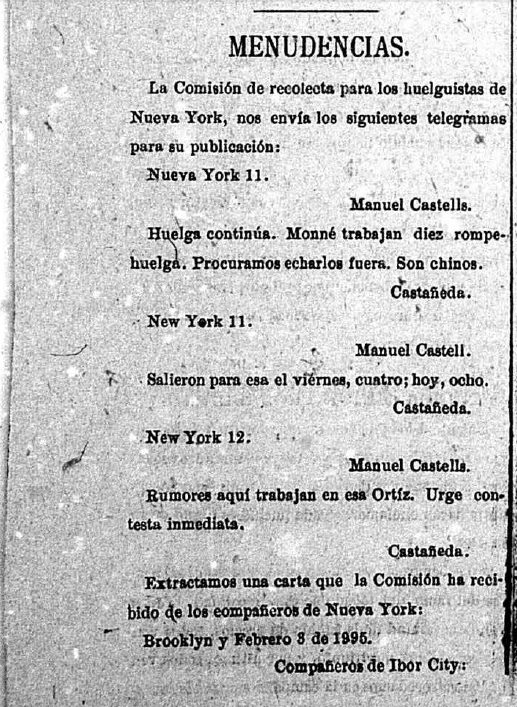Raíces españolas en Brooklyn / Spanish Roots in Brooklyn

La andadura de la investigación
El origen castellano. Becilla de Valderaduey
La continuidad Castañeda en Estados Unidos. Brooklyn, Nueva York
La andadura de la investigación
Una historia de vida siempre ilustra otras muchas vivencias. Experiencias todas, particulares y colectivas, inscritas en el contexto histórico que las determinan y el que a la vez escriben. Al fin, la microhistoria es una de las formas de hacer Historia.
Con este guion la investigación resuelta sobre Agustín Castañeda Alonso, mi bisabuelo, se narra en el escenario del fenómeno migratorio de españoles a Estados Unidos en la segunda mitad del siglo XIX. El encuadre es importante porque es una llamada de atención más hacía esa historia de la inmigración invisible de los españoles en Estados Unidos que no ha tenido películas ni días de conmemoración especiales, pero que está siendo estudiada con renovado interés[1]. Al respecto y en particular en este artículo se recogen notas sobre la aportación de una cultura política anarquista española al panorama estadounidense, aún pendiente de estudiar en toda su dimensión. También, se cruza la guerra civil española (1936-1939) y las terribles consecuencias que la represión franquista tuvo sobre la familia Castañeda en España.
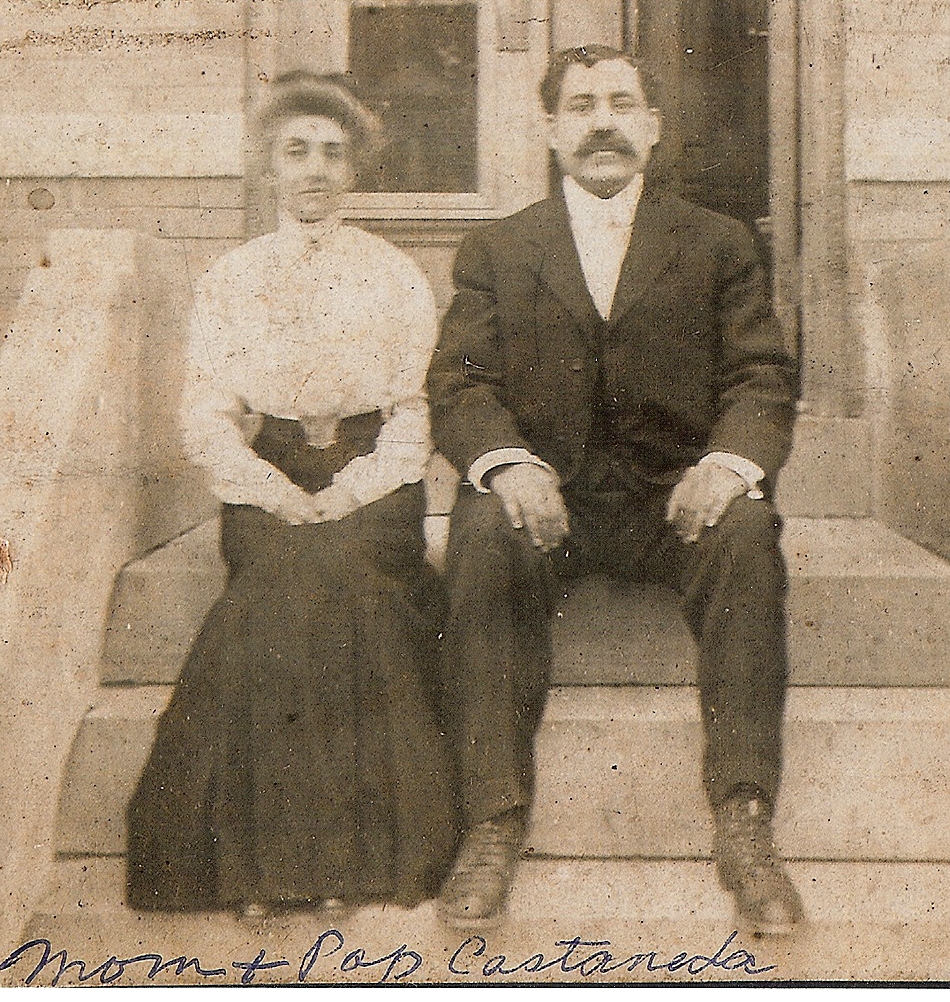
La investigación había comenzado años antes, tan solo hilada por los relatos familiares y mantenida en una larga pausa ante la falta de documentación. Hasta agosto de 2018, cuando finalizó con éxito el trabajo histórico y genealógico, ninguno de los descendientes de mi bisabuelo tenía conocimiento de su lugar de nacimiento concreto, ni de los acontecimientos de su niñez y juventud en España. Así como, también, permanecía en la sombra de la memoria familiar la mayor parte de su devenir americano. Por tanto, la investigación para la reconstrucción de la genealogía familiar debía iniciarse dando luz a la vida de Agustín Castañeda: el sujeto principal del estudio. Desde luego principal para mí, emocionalmente, por la cercanía en el recuerdo de la familia que trasmitía la admiración por el arriesgado antepasado que cruzó el Atlántico y por su personalidad de singular interés.
La búsqueda de información fue lenta y complicada, utilicé todos los recursos posibles a mi alcance: consultas bibliográficas, en la Red, en archivos, a genealogistas, pruebas de ADN, etcétera. A pesar de todo este trabajo el rastro de mi bisabuelo en España no aparecía. El único dato fiable de partida que tenía es un recordatorio del día y mes de su cumpleaños, el 18 de febrero, sin indicación del año, que en memoria de Agustín Castañeda publicó su viuda en el periódico Brooklyn Daily Eagle, (18 febrero 1932) y un perfil fascinante emergido de la prensa histórica que retrataba a Agustín como un activista anarquista e implicado en el movimiento sindical. Una información que coincidía con la ética personal recordada por sus inmediatos descendientes. No fue hasta el dicho verano del 2018 cuando comenzó a rodar la investigación, en la medida que cuadraron ciertas pistas del estudio de ADN con el lugar concreto de Becilla de Valderaduey en la provincia de Valladolid y comarca de Tierras de Campos, ya en este momento con la colaboración de la historiadora María Teresa Díez Martín.
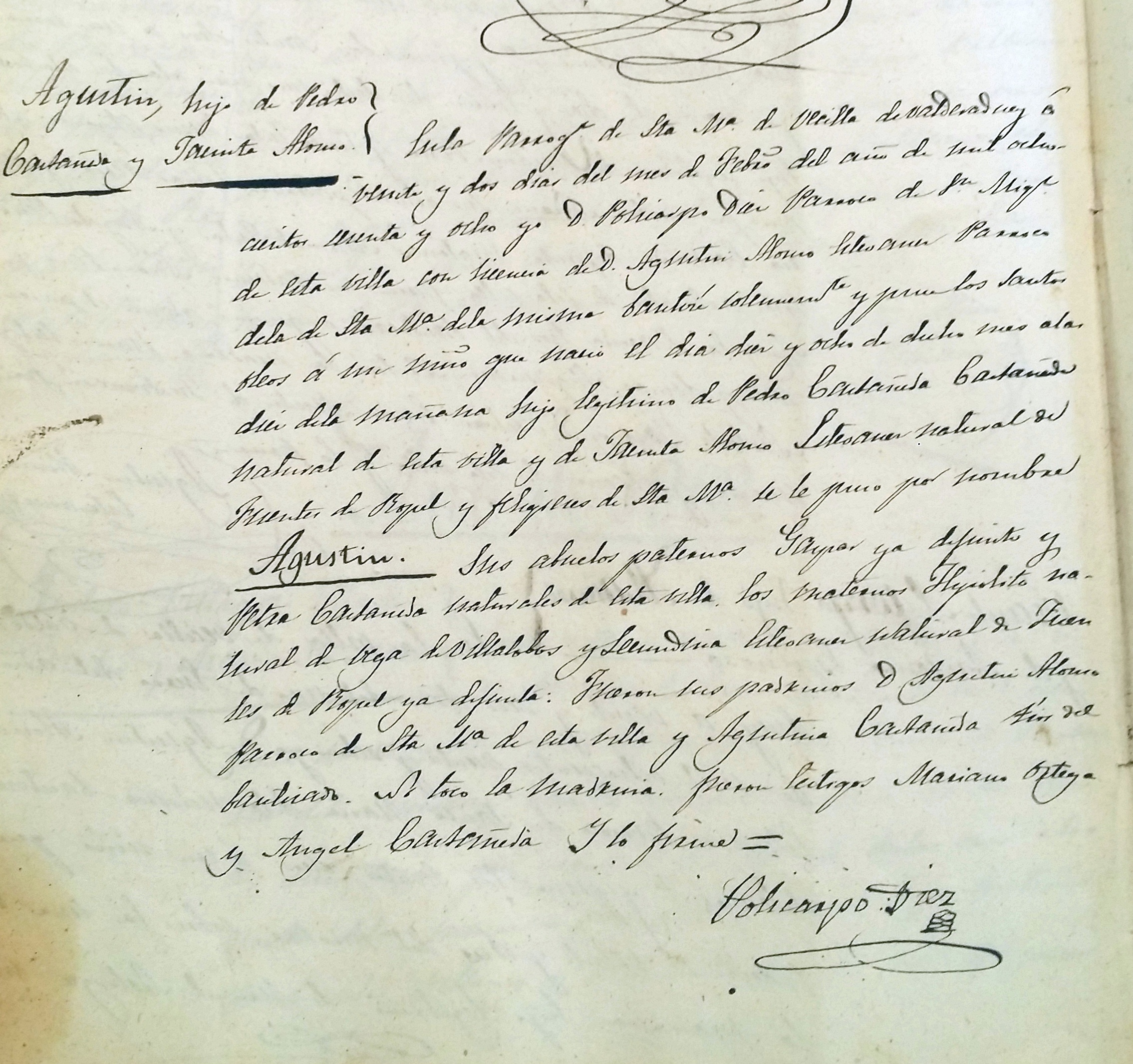 Registro parroquial. Bautismo de Agustín Castañeda Alonso, 1868
Registro parroquial. Bautismo de Agustín Castañeda Alonso, 1868
Aunque una investigación genealógica tan compleja como esta no termina de cerrarse en mucho tiempo, se puede, ahora, dar por averiguadas las etapas fundamentales del transcurrir vital de Agustín y la de una genealogía Castañeda entre dos mundos: de la Tierra de Campos de Castilla a América, del norte y sur. Dentro está, entonces, con plena justificación, esta microhistoria en la temática de la emigración española a América, cuyo motor ha sido, desde la conquista hasta el presente, el ideario social de hacer fortuna en tierras americanas, el «hacer las Indias» o después «hacer las Américas».
Así, pues, con mucho empeño y un poco de suerte, he podido reconstruir con éxito esta historia familiar. Es un rescate, está claro, ya que esta historia podría haberse perdido para siempre de no mediar el interés particular por la sacarla a la luz.
El origen castellano. Becilla de Valderaduey
Sin duda el documento clave fue la partida de bautismo de Agustín, que informa del nacimiento de Agustín Castañeda en el citado pueblo el 18 de febrero de 1868. Sus padres eran Pedro Castañeda Castañeda y Jacinta Alonso Estébanez. Se le puso el nombre por su padrino, siguiendo una asentada costumbre, que fue Agustín Alonso Estébanez, su tío, hermano de su madre y párroco de una de las iglesias del pueblo. Mi bisabuelo fue el segundo de cuatro hermanos nacidos del segundo matrimonio de un prolífico Pedro Castañeda que tuvo un total de 14 hijos con sus dos esposas, y confirma en ello el mismo abundamiento reproductivo de la línea Castañeda en Becilla desde el siglo XVII. Agustín tenía dos hermanas y un hermano, Daniela, Amadea y Fabián, además de diez hermanastros y hermanastras del primer matrimonio de su padre.
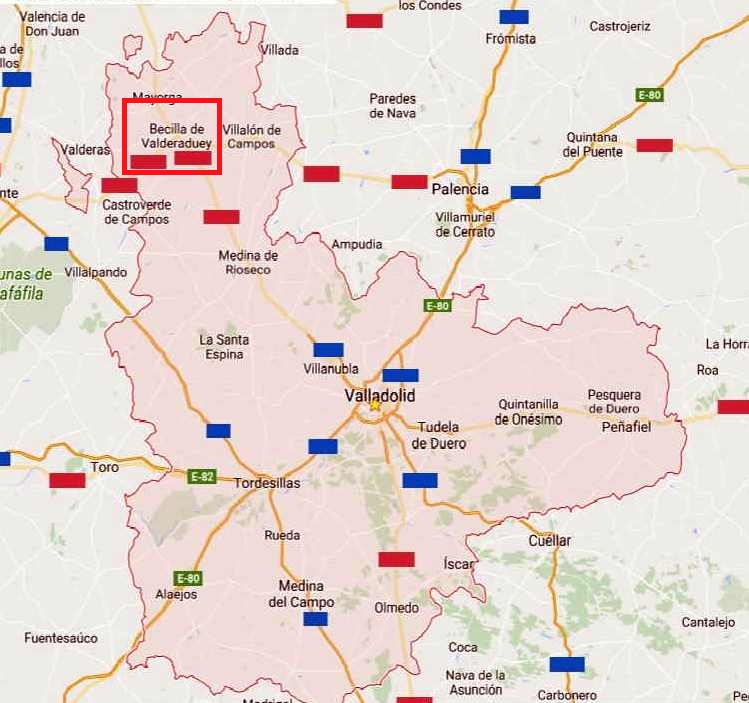
Algunos rumores previos de la familia sobre estos parientes más directos se confirmaron en el estudio, así la existencia de un hermano militar que resultó ser su hermanastro Aniceto Castañeda Díez, militar de carrera que sirvió en la guerra de Cuba (1868-1898), probablemente en varias campañas, y que incluso fue noticia en la prensa de la época en 1895[2]. Es factible especular que Agustín pudo acompañar al comandante Aniceto a Cuba o que este facilitara de alguna forma la migración, pues, aunque no se ha conseguido el registro de emigración de Agustín el recuerdo familiar informa de que su primer destino americano fue en estas islas.
También, la investigación ha dado sorpresas, como la que relata la emigración de su hermana mayor Daniela a Argentina en 1908, en compañía de su esposo, Manuel Peña González, y sus cuatro hijos de corta edad. Es la constancia de una dispersión familiar propiciada por emigraciones de tanto calado como las intercontinentales. No sabemos hasta qué punto se conservó el contacto entre los hermanos, pero es una realidad que los lazos familiares se deshicieron, pues hasta esta investigación ambas ramas familiares se desconocían. En la actualidad, ha sido una gran satisfacción contactar con los Castañeda argentinos por medio de Paola, una bisnieta de Daniela que vive en Buenos Aires.
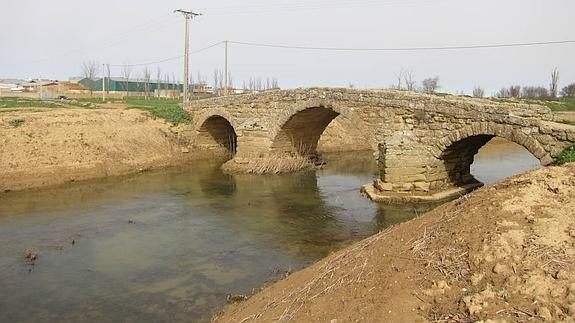
No faltan los acontecimientos trágicos en los hallazgos. La brutal represión franquista, durante y después de la Guerra Civil, tocó de lleno a la línea Castañeda en la familia de la otra hermana de mi bisabuelo, Amadea, en la que todos sus miembros fueron torturados y encarcelados, incluida Amadea, y uno de los hijos del matrimonio que formó con Vicente Pérez del Agua fue asesinado. El joven fue Secundino Pérez Castañeda. Ocurrió en Ceinos de Campos, pueblo cercano a Becilla, donde residió la familia de Amadea. Demasiado sufrimiento del que aún faltan muchos detalles. La familia de Amadea ya forman parte del registro de la Memoria Histórica que en Valladolid ha trabajado la activista y estudiosa, Orosia Castán Lanaspa [3]. El extracto de los datos es el que sigue:
Ceinos de Campos (Valladolid). Familia Pérez- Castañeda “Besugos
Amadea Castañeda Alonso, encarcelada, con una edad cerca de la sesentena.
Su marido, Vicente Pérez del Agua, encarcelado.
Hijos e hija del matrimonio, naturales de Ceinos de Campos. – Secundino, asesinado, 34 años. Casado con Laureana García de la Loma, dejó tres hijos. – Pedro, detenido, torturado. Soltero – Engracio, detenido, torturado. Casado con Ausencia García Hernández. – Bernarda, rapada, torturada. Casada[4]
Se pone de manifiesto una ideología familiar de izquierdas, al menos en la parte de los sujetos desvelados en la investigación, que informa y da coherencia a la militancia anarquista de Agustín Castañeda que más adelante se trata.
Encontrar el documento del bautismo de Agustín también permitió emprender un viaje genealógico fascinante a un pasado remoto. Hasta un Juan Castañeda nacido sobre 1600 y fallecido en 1662. Una sucesión de generaciones hasta mi bisabuelo Agustín que vivieron en Becilla durante cientos de años. La dinámica vivencial de esta línea genealógica retrata la sociedad rural castellana, y aunque falta más investigación histórico-social sobre esta genealogía Castañeda, en general, parece, que, hasta la contemporaneidad de los emigrados en el XIX y la ocupación militar de Aniceto Castañeda, todos fueron labradores más o menos acomodados, y algunos clérigos. Un perfil de interés que ha sido rescatado es el de mi séptimo abuelo, Luis Castañeda de la Peña (1668-1732), que fue alcalde ordinario de Becilla de Valderaduey hace trescientos años.
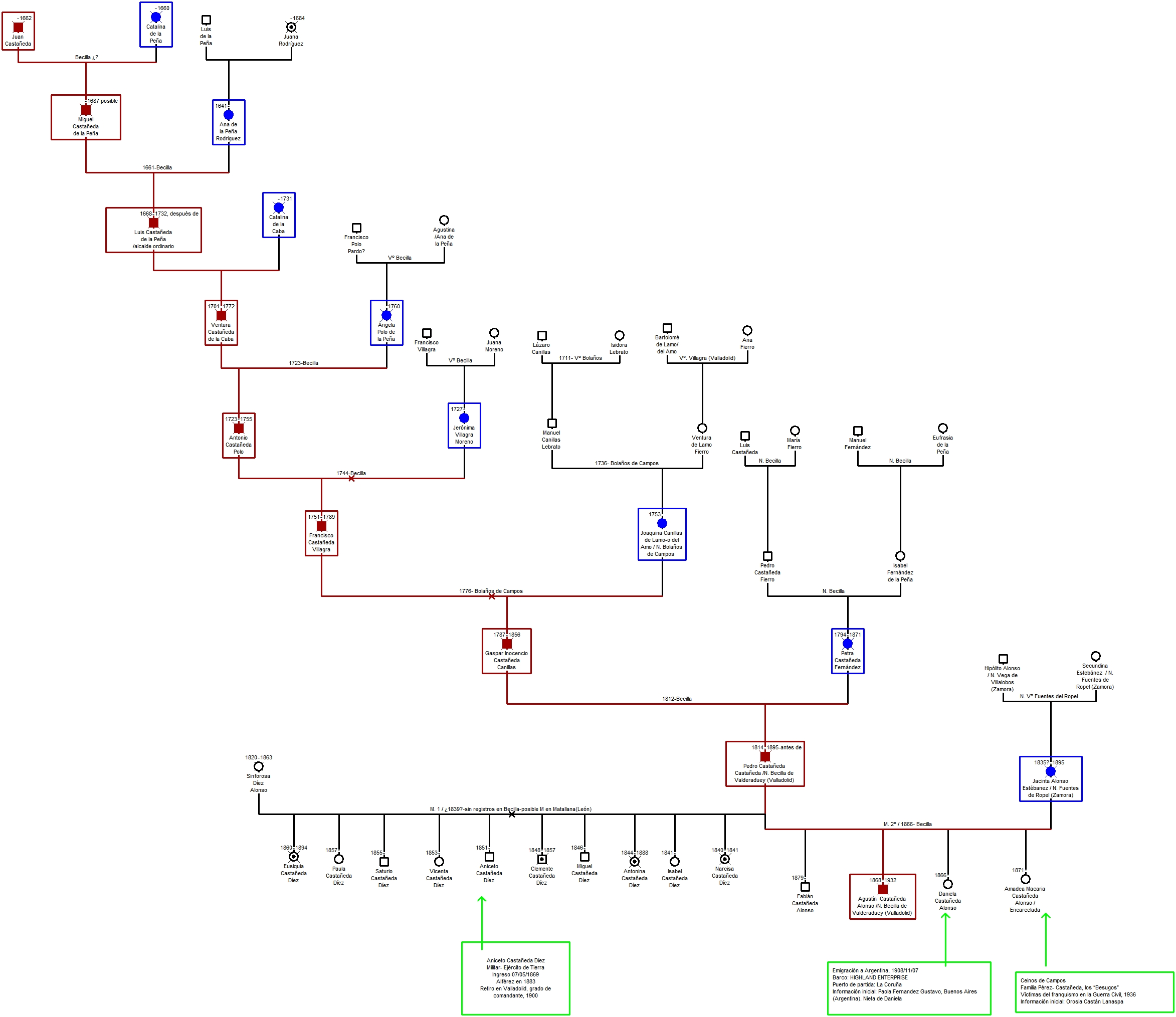
La continuidad Castañeda en Estados Unidos. Brooklyn, Nueva York
Agustín Castañeda Alonso falleció en Brooklyn el 1 enero 1932, donde había residido durante cuarenta años y formado una familia. Es muy probable que llegará en 1890 o 1891, pues, aunque, como se ha dicho, no ha aparecido ningún registro de inmigración se pueden cuadrar fechas en el conjunto de datos. Poco después, se casó con Margaret Elizabeth Broint, hija de un comerciante de cigarros cubano y una madre irlandesa[5], de cuyo matrimonio nacieron seis hijos-as. Según las noticias familiares, hubo alguna tensión entre los cónyuges por disparidad de creencias, ya que el ateísmo anarquista de Agustín chocó con el catolicismo irlandés de su esposa, al menos en ese sentido consta en el relato que mi bisabuelo se opuso al bautismo de sus hijos-as y Elizabeth los llevó por su cuenta a la pila bautismal, a espaldas de Agustín.
Agustín trabajó como empleado en la manufactura de cigarros puros, cuya actividad en Nueva York estaba concentrada en Brooklyn. Industria que organizada en pequeños talleres empleaba una mayoría de trabajadores hispanos, españoles y cubanos. En una segunda etapa mi bisabuelo regentó su propia expendeduría de tabaco en la calle 85 en Brooklyn[6].
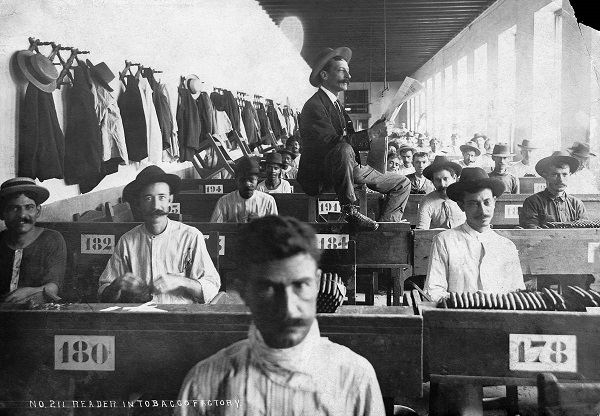
Son pinceladas del cuadro de la emigración multitudinaria de españoles a América durante la segunda mitad del siglo XIX, principalmente del norte peninsular y que en número importante y significativo se afincaron en Cuba y Estados Unidos. Un movimiento migratorio a estos países que respondió primero al efecto llamada de un entramado industrial tabaquero español en Cuba y después de la crisis cubana de esta industria a su desarrollo en Tampa (Florida), aquí ya produciéndose una doble migración hispana, la de cubanos y la de españoles desde Cuba o España[7]. Es el contexto material que explica no solo la subsistencia de la familia de Agustín Castañeda, también las relaciones sociales que este estableció, su actividad política e incluso puede explicar su matrimonio con una mujer cercana en el colectivo social de los trabajadores del tabaco hispanos. En definitiva, fuertes lazos que unieron a la comunidad hispana en torno a los negocios del tabaco y que, de forma significada, crearon identidades sociales particularizadas.
Poco después de llegar a Brooklyn, Agustín comenzó su práctica militante en el sindicato «Obreros del ramo de tabaco Habana de Nueva York»[8], organización con predominio del obrerismo anarquista, en la que tuvo cargos administrativos y responsabilidades en los comités de huelga. Así como, también, mantuvo una activa correspondencia con los sindicalistas de Ybor City (Tampa) que era un centro neurálgico del movimiento obrero. Así mismo, consta que contribuyó económicamente a la causa de los presos políticos en España y Cuba, incluyendo la viuda de Paulino Pallás, otros periódicos laborales, y varios huelguistas[9]. De todo ello informa la prensa anarquista, una fuente inestimable de información en esta investigación. Es observable, para el registro familiar, que sus descendientes no guardaron recuerdo de esta actividad político-sindical. De hecho, ninguno de los más inmediatos, hijos e hijas de Agustín, parece que tuvieran interés alguno por la política.
Telegramas de Agustín Castañeda a Manuel Castells, El Esclavo (Tampa/Ybor City), 14 febrero 1895.[/caption]
En Brooklyn durante la última década del siglo XIX, un grupo de militantes libertarios españoles y cubanos publicó un periódico llamado El Despertar. Periódico anarquista (Nueva York 1891-1902), que fue distribuido en España, EE. UU. y América Latina. Una prensa de vanguardia anarquista que trató múltiples temas del movimiento obrero a la vez que con las noticias de España mantenía los vínculos emocionales del colectivo migrante. Fue en este periódico donde Agustín Castañeda ejerció como administrador. Además, hay otros rastros de su actividad militante en la prensa anarquista como cartas y telegramas en el El Esclavo (Tampa, 1894-1898).
Es evidente que en esta década de los noventa la comunidad hispana de Brooklyn vivió en un intenso clima político impulsado por la potencia del movimiento obrero, en el que se aunaban militantes de izquierda, sindicalistas e intelectuales. En este sentido es de gran interés que el circulo anarquista contara en este tiempo con residentes en Brooklyn de elevada talla intelectual y política, como, entre otros más, Pedro Esteve, escritor y editor catalana, Adrián del Valle, ideólogo libertario, o el cubano José Campos, corresponsal y ensayista. Parece que fue un momento y lugar vibrante para los hispanos de libre pensamiento. El declive no supero el fin de siglo, pues la comunidad ideológica quedó desarticulada con la guerra hispano–estadounidense, o en España la guerra de Cuba (1898), y la frustración del ideario anarquista por el fracaso de la revolución.
En 1902, el periódico El Despertar había desaparecido y con el mismo las huellas públicas de Agustín. Reapareció el diario anarquista por un breve período de tiempo, desde finales de 1909 hasta los primeros meses de 1910. Fue una más de las reacciones de movilización y protesta internacional en Europa y América por la ejecución el 13 de octubre de 1909 del catalán Francisco Ferrer i Guardia, pedagogo anarquista, librepensador y fundador de la Escuela Moderna[10]/[11]. En esta misma oleada, y según consta en el último registro público que he encontrado, Agustín Castañeda junto a Jaime Vidal, del exilio catalán, ayudó a organizar The Spanish Pro-Revolution Committee (Comité de la Revolución Española), que se inició con la organización de la protesta por la ejecución de Ferrer y extendió su acción a la propagación del objetivo de la revolución en España y la consiguiente campaña de recaudación de fondos para tal fin. La acción contó con múltiples apoyos, entre ellos el de la conocida anarquista rusa en Estados Unidos Emma Goldman.
Por supuesto, la investigación continúa abierta, pues quedan aún lagunas, incógnitas por resolver. En definitiva, mucho por conocer y comprender para la narración completa de esta línea Castañeda que transcurre entre Estados Unidos y España. Entre dos mundos culturales.
El autor
Christopher J. Castañeda
Es profesor de historia en California State University, Sacramento
Autor de: “`Yours for the revolution’: Cigar Makers, Anarchists and Brooklyn’s Spanish Colony, 1878-1925,» in Hidden Out in the Open: Spanish Migration to the United States (1875-1930) Co-edited by Phylis Martinelli and Ana Varela-Lago (University of Colorado Press, 2018) y co-editor con Montse Feu de Writing Revolution: Hispanic Anarchism in the United States (University of Illinois Press, 2019)
Notas
[1] Valga como referencia al hilo del parafraseo, y entre otras muchas, el trabajo de James D. Fernández & Luis Argeo, Invisible Immigrants: Spaniards in the US (1868-1945), New York: White Stone Ridge, 2014. https://www.kickstarter.com/projects/538868554/invisible-immigrants-spaniards-in-the-us-1868-1945
https://www.playgroundmag.net/now/Invisible-Immigrants-espanoles-Estados_22683084.html
[2] Biblioteca de prensa histórica, El Correo de España-Año II, nº 83, 1895-Diciembre-29
[3] A quien agradezco su colaboración en el esclarecimiento de este espeluznante episodio de la familia Castañeda.
[4] Orosia Castán Lanaspa, entrevista oral a Julián Peña Rivera, 88 años, Becilla de Valderaduey (Valladolid), 03/03/2004. Verdad y Justicia http://www.represionfranquistavalladolid.org/
[5] No se ha encontrado registro de este matrimonio.
[6] Un buen resumen divulgativo de la actividad tabaquera en EE.UU, Cuba y España durante el siglo XIX se puede recomendar en esta dirección http://www.jaberni-coleccionismo-vitolas.com/1C.5.06-Grandes_Tabaqueros_EEUU.htm
[7] Un estudio clarificador de este fenómeno migratorio en ESTEVE, A.; TORRENTS, A.; CORTINA, C. La emigración española a Estados Unidos: una aproximación desde los microdatos censales de 1910. Geo Crítica / Scripta Nova. Revista electrónica de geografía y ciencias sociales. Barcelona: Universidad de Barcelona, 1 de marzo de 2005, vol. IX, núm. 184. http://www.ub.es/geocrit/sn/sn-184.htm
[8] El Despertar, New York (October 1, 1891).
[9] El anarquista Paulino Pallás fue ejecutado por su intento de asesinato del comandate general de Cataluña, Arsenio Martínez Campos. Fue ejecutado el 6 de octubre de 1893.
[10] https://es.wikipedia.org/wiki/Francisco_Ferrer_Guardia
[11] http://www.ferrerguardia.org/es/la-escuela-moderna
SPANISH ROOTS IN BROOKLYN
Contenido
The Castilian origin: Becilla de Valderaduey. 3
The continuity of this Castañeda line in the United States: Brooklyn, New York. 5
Research path
A life history always illustrates many other experiences. And all these experiences, both private and collective, are inscribed within the historical context that determines them as well as the focus of the study. Ultimately, microhistory is a way of understanding the broad contours of history as well as the particular subject of the investigation.
From this perspective, the research about the life of Agustín Castañeda Alonso, my great-grandfather, is narrated within the historical context of Spanish migration to the United States during the second half of the nineteenth century. This framing is important because it helps to expand our understanding of the invisible immigration of Spaniards to the United States, a movement not recorded on film or acknowledged on special days of commemoration, but it is now being studied with renewed interest[1]. In addition, this article recognizes the contribution of a Spanish anarchist political culture in the American landscape, a topic that requires further work so that we can better understand it in a more complete dimension. This essay also crosses into the Spanish Civil War (1936-1939) and the terrible consequences that the Franco repression had on the Castañeda family in Spain.
[image] Agustín Castañeda Alonso with his wife Elizabeth Broint, Brooklyn, about 1900.
I began this research many years ago (in fact, my father initiated it years before he passed away in 2008). Initially spun by a few family stories, it remained incomplete for years due to a lack of documentation. Finally, in August 2018, a combination of intensive academic and genealogical research resulted in remarkable success. Until then, none of my great-grandfather’s descendants had known of his place of birth or had any knowledge whatsoever of his childhood or youth in Spain. Consequently, much of my great-grandfather’s life had remained in the deep shadows of limited family memory. Nevertheless, research to reconstruct the family history gradually began to uncover the life of Agustín Castañeda: the main subject of the study. Of course, my motivation was exploring what was lost in the family memory about this ancestor who had admirably accepted the risk of crossing the Atlantic; this was my primary interest.
The search for information was slow and complicated. I used all the possible resources a professional historian could engage: bibliographies, internet searches, archival work, consultations with genealogists, DNA tests, and so on. In spite of all my intensive work, Agustín’s trail that began in Spain remained totally hidden. The only reliable clue I had located was the day and month of his birthday, February 18, but without a certain indication of the exact year. This information appeared in a eulogy that Agustín Castañeda’s widow published in the Brooklyn Daily Eagle newspaper on February 18, 1932. Although his life in Spain remained unknown, the research unexpectedly uncovered a fascinating profile of life in the U.S., a man who had joined an anarchist community and was active in the cigar makers’ labor movement. Some of this newly developed information seemed tantalizingly consistent with the few stories about his personal ethics remembered by immediate descendants. But it was not until the summer of 2018 when this investigation specifically on the Spanish connection began to move forward rapidly. Suddenly, new DNA matches pointed to a particular town (and one totally unsuspected), Becilla de Valderaduey, in the province of Valladolid and region of Tierra de Campos. By chance, I had already collaborated with the historian María Teresa Díez Martín, who was located in Valladolid, and she quickly identified a tremendous cache of documents directly related to Agustín’s Spanish family.
[image ] Parish Registry Baptism of Agustín Castañeda Alonso, 1868
Although a genealogical investigation as complex as this one has been and continues to be, it is now possible to link the fundamental stages of Agustín’s adult life in the United States with a genealogy rooted in Spain. This link connects two worlds: from the «Tierra de Campos» (Land of the Fields) of Castile to Brooklyn, New York in America. From the inside then, and with full justification, this microhistory is directly relevant to the broader topic of Spanish emigration to America, whose engine has been from the conquest to the present, the social ideology of making a fortune in American lands, ie., «Making the Indies» (Hacer las Indias) and later referred to as «Making the Americas» (Hacer las Américas). So, with much effort and some well-placed luck, we have been able to successfully reconstruct a lost and forgotten family history. It is a rescue and recovery effort, of course, since this story would have been lost forever if there had not been a particular interest or willingness, ie., personal motivation in this case, to spend the immense amount of time to bring it to light.
The Castilian origin: Becilla de Valderaduey
Without a doubt, the key document that opened the door for what became an expansive genealogy was Agustín Castañeda’s baptismal certificate that reports his birth in Becilla de Valderaduey precisely on February 18, 1868, the very date of course that his wife had identified when commemorating his death in Brooklyn in 1932. His parents were Pedro Castañeda Castañeda and Jacinta Alonso Estébanez. He was named after his godfather, following an established custom, who was Agustín Alonso Estébanez. The same godfather was also Agustín’s uncle, his mother’s brother, as well as pastor of one of the town’s churches. We learned quickly that my great-grandfather was the second of four siblings born from the second marriage of a prolific Pedro Castañeda who had a total of 14 children with his two wives, and this confirms the same reproductive abundance of the Castañeda line in Becilla since the seventeenth century. Therefore, Agustin had two sisters and one brother, Daniela, Amadea, and Fabián, as well as ten step-brothers and half-sisters from his father’s first marriage.
[image] Location of Becilla de Valderaduey in the Valladolid provincial map (See the article in Spanish)
A couple vague rumors in the family lore about close relatives were confirmed in the study, including the existence of a military brother who turned out to be Agustín’s stepbrother, Aniceto Castañeda Díez. He was a career soldier who served in the war in Cuba (1868-1898), probably in several campaigns, and his name in relation to military engagement appeared in the press at least once during 1895[2]. It is reasonable to speculate that Agustín had been able to accompany Aniceto to Cuba, or that Aniceto somehow facilitated Agustín’s migration, because, although Agustín’s emigration record has not been achieved, family lore suggested that his first American destination was Cuba.
This investigation has produced other surprises, such as the documented story of the emigration of Agustín’s older sister, Daniela, to Argentina in 1908, in the company of her husband, Manuel Peña González, and their four young children. This was a family that represented both intercontinental migration, but there were many others who remained in the area. We do not yet know to what extent there was contact among the siblings or other family members, but it is a reality that family ties were undone, because until this investigation both of these particular migrating family branches were unknown to each other. Consequently, it has been a great joy for me to be in contact the Argentine Castañeda family through Paola, a great-granddaughter of Daniela, who lives in Buenos Aires.
[image] Becilla de Valderaduey, Roman bridge (See the article in Spanish)
Neither are tragic events lacking in these findings. The brutal Franco repression, during and after the Civil War, brazenly and directly affected the immediate family of my great-grandfather’s other sister, Amadea, of whom all its members were tortured and imprisoned, including Amadea herself. One of her sons from her marriage to Vicente Pérez del Agua was murdered; this young man was Secundino Pérez Castañeda. It happened in Ceinos de Campos, a town near Becilla, where Amadea’s family lived; too much suffering about which many details are still missing. Amadea’s family is already part of the Historical Memory register for which the activist and scholar, Orosia Castán Lanaspa, has worked in Valladolid[3]. The data extract is as follows:
Ceinos de Campos (Valladolid). Pérez Family- Castañeda “Besugos
- Amadea Castañeda Alonso, imprisoned, with an age near the age of sixty.
- Vicente Pérez del Agua, husband of Amadea, jailed.
Children and daughter of the marriage, native of Ceinos de Campos
- – Secundino: murdered, 34 years old. Married to Laureana García de la Loma, he left three children.
- – Pedro: arrested and tortured. Single.
- – Engracio: arrested and tortured. Married to Ausencia García Hernández.
- – Bernarda: raped and tortured. Married[4]
This information about Agustin’s sister’s family provides another example of an «ideology of the left» in some family members, at least as revealed so far in this research. It does inform and give coherence to the anarchist militancy of Agustín Castañeda, which is later discussed in this essay.
Finding Agustín’s baptismal document also allowed us to undertake a fascinating genealogical trip to a remote past. This takes us back to one Juan Castañeda who was born about 1600 and died in 1662. A succession of Castañeda fathers who lived in Becilla for hundreds of years continued through the years to that of my great-grandfather’s birth, and continued still. The experiential dynamics of this genealogical line portrays the Castilian rural society, and although more historical-social research is needed on this Castañeda genealogy, in general, it seems that until contemporary times the emigrants of the 19th century and the military position of Aniceto Castañeda, all were more or less well-off farmers, along with some clergymen. One profile of local and genealogical interest which has been rescued is that of my seventh grandfather, Luis Castañeda de la Peña (1668-1732), who was the mayor of Becilla de Valderaduey three hundred years ago.
[image] Genogram of the Castañeda Line in Becilla de Valderaduey / Extensive Castañeda Genogram (See the article in Spanish)
The continuity of this Castañeda line in the United States: Brooklyn, New York
Agustín Castañeda Alonso died in Brooklyn on January 1, 1932, where he had lived, worked and raised a family for forty years. It is most likely that he arrived there in 1890 or 1891, because as stated earlier while no immigration record has been located, certain dates can be deduced from the historical context. Shortly after he arrived, he married Margaret Elizabeth Broint who was the daughter of a Cuban cigar merchant and an Irish mother[5] from whose marriage six children were born. According to family lore, there was some tension between the spouses due to disparity of beliefs, since Agustin’s apparent anti-Catholicism (no descendant ever mentioned an «anarchist» sensibility) collided with his wife’s Irish Catholicism, at least in the sense that one family story was that my great grandfather opposed the baptism of his children, but Elizabeth took them on her own and possibly without Agustín’s, knowledge to the baptismal font.
For many years, Agustín worked as an employee in the manufacture of Cuban tobacco cigars, an activity that was concentrated in a part of Brooklyn and New York City. This industry was largely comprised of small workshops that typically employed Hispanic, Spanish and Cuban workers. Later, my great-grandfather ran his own tobacco shop on 85th Street in Brooklyn[6].
These are brushstrokes of the mass emigration of Spaniards to America during the second half of the nineteenth century, mainly from the peninsular north and which in significant numbers settled in Cuba and the United States. This was a migratory movement to these countries that responded in part to the so-called pull of a Spanish industrial tobacco network in Cuba and after the Cuban crisis of this industry to its development in Tampa (Florida), producing a double Hispanic migration, that of Cubans and that of Spaniards from Cuba or Spain[7]. It is the material context that explains not only the livelihood of Agustín Castañeda’s family, but also the social relations he established, his political activity and can even explain his marriage to a woman connected to the social group of Hispanic tobacco workers. In short, strong ties that united the Hispanic community around tobacco businesses and that, in a meaningful way, created particularized social identities.
Shortly after arriving in Brooklyn, Agustin also began his activist involvement with the «Obreros de ramo de tabaco Habana de Nueva York» (Workers of the Havana Tobacco Branch of New York)[8], a radical labor organization composed of many Hispanic anarchist workers, in which he held administrative positions and responsibilities in strike committees. During these years, he maintained an active correspondence with fellow labor activists in Ybor City (Tampa) which was then a major nerve center of the movement. Likewise, it is evident that he contributed financially to the cause of political prisoners in Spain and Cuba, including the widow
by Paulino Pallás, other labor newspapers, as well as fellow strikers[9]. The anarchist press reports these activities; it is an invaluable source of information for this investigation. Indeed, it is only in these newspapers that much of this history can be recovered. His descendants (and this is demonstrably true for other activists of the same time and place) either did not know or did not retain any memory of these activities. In fact, none of Agustín’s sons or daughters seemed to have had any interest at all in politics.
[image] Telegrams from Agustín Castañeda to Manuel Castells, El Esclavo (Tampa / Ybor City), February 14, 1895 (See the article in Spanish)
In Brooklyn during the last decade of the 19th century, a group of militant Spanish and Cuban freethinkers organized a newspaper called El Despertar: Periódico Anarquista (New York 1891-1902), which was distributed in Spain, the United States, and Latin America. This was an avant-garde newspaper that dealt with a variety of issues related to the labor movement while maintaining close ties to the migrant collective and regularly printing news from Spain. It was for this newspaper that Agustín Castañeda served as administrator for several years. In addition, there are other traces of his militant activity in the transnational anarchist press in the form of letters and telegrams including those printed in El Esclavo (The Slave, Tampa, 1894-1898).
El Despertar (The Awakening), 1895
It is evident that in the decade of the 1890s, Brooklyn’s Hispanic community lived in an intensely political climate strongly influenced by the power of the labor movement, in which leftist militants, trade unionists and intellectuals often joined together. In this sense, it is of great interest that the anarchist circle during these years included Brooklyn residents of high intellectual and political stature, including Pedro Esteve, the Catalan writer and editor; the Spanish dramatist Adrián del Valle; and the libertarian Cuban correspondent and essayist José Campos. It was an intense historical moment and vibrant place for free thinking Hispanics. This community’s decline commenced with the end of the century, because the ideological community was frayed in part due the Spanish-American War (or in Spain, the War in Cuba, 1898), and frustration within the anarchist community by the failure of the revolution.
In 1902, the newspaper El Despertar had disappeared along with one of the best sources of information about Agustín’s footprints. But his community’s anarchist militancy reappeared for a brief time, from the end of 1909 until early 1910. This activity was part of an international mobilization and protest in Europe and America following the execution on October 13, 1909 of the Catalan Francisco Ferrer i Guardia, the anarchist pedagogue, freethinker and founder of the Modern School[10]. It was in response to Ferrer’s execution that I found (as of this date) the last public record of Agustín Castañeda’s militancy when together with Jaime Vidal, the Catalan exile, they helped organize the Spanish Pro-Revolution Committee, which organized to protest the execution of Ferrer and call for a revolution in Spain, along with a fundraising campaign for this purpose. This action had multiple supporters, including Emma Goldman, the well-known Russian anarchist then living in the United States.
Of course, the research continues, as there are still many gaps and unknowns yet to be resolved. In short, there remains much to know and understand in order to develop a fuller and more complete narration of this Castañeda line that runs between the United States and Spain, and the larger historical context that existed between and connected these two cultural worlds.
The author
Christopher J. Castañeda, in collaboration with Mayte Díez Martín
He is a history professor at California State University, Sacramento and author of: «‘Yours for the revolution’: Cigar Makers, Anarchists and Brooklyn’s Spanish Colony, 1878-1925,» in Hidden Out in the Open: Spanish Migration to the United States (1875-1930) Co-edited by Phylis Martinelli and Ana Varela-Lago (University of Colorado Press, 2018) and co-editor with Montse Feu of Writing Revolution: Hispanic Anarchism in the United States (University of Illinois Press, 2019)
Notes:
[1] See the work of James D. Fernández & Luis Argeo, Invisible Immigrants: Spaniards in the US (1868-1945), New York: White Stone Ridge, 2014. https://www.kickstarter.com/projects/538868554/invisible-im migrants-spaniards-in-the-us-1868-1945 and https://www.playgroundmag.net/now/Invisible-Immigrants-espa noles-States_22683084.html
[2] Historical press library, El Correo de España-Year II, no 83, 1895-December-29
[3] To whom I thank for her collaboration in clarifying this tragic episode of the Castañeda family.
[4] Orosia Castán Lanaspa, oral interview with Julián Peña Rivera, 88, Becilla de Valderaduey (Valladolid), 03/03/2004. Truth and http://www.represionfranquistavalladolid.org/
[5] No record of this marriage has been found.
[6] A good informative summary of tobacco activity in the US, Cuba and Spain during the 19th century can be read in this http://www.jaberni-coleccionismo-vitolas.com/1C.5.06-Grande s_Tabaqueros_EEUU.htm
[7] A supplentary study of this migratory phenomenon in ESTEVE, A.; TORRENTS, A .; CORTINA, C. Spanish emigration to the United States: an approach from the census microdata of 1910. Geo Crítica / Scripta Nova. Electronic magazine of geography and social sciences Barcelona: University of Barcelona, March 1, 2005, vol. IX, no. 184. http://www.ub.es/geocrit/sn/sn-184.htm
[8] El Despertar, New York (October 1, 1891).
[9] The anarchist Paulino Pallás was executed for his assassination attempt on the general commander of Catalonia, Arsenio Martínez Campos. He was executed on October 6, 1893.
[10] https://es.wikipedia.org/wiki/Francisco_Ferrer_Guardia
http://www.ferrerguardia.org/es/la-escuela-moderna
